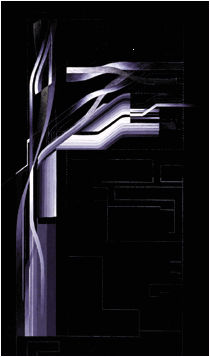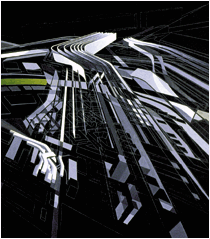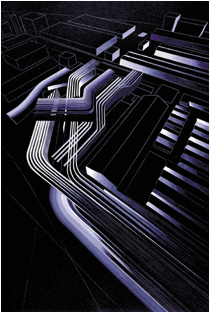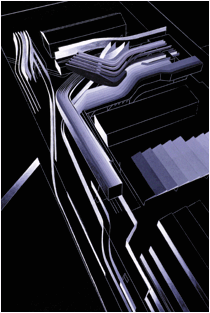
Diller
+ Scofidio
Bad Press
Ted Kruger
Metadermis- Like a Second Skin
Yehuda safran
Planet Zaha Hadid And Souto de Moura
Bad Press
Ted Kruger
Metadermis- Like a Second Skin
Yehuda safran
Planet Zaha Hadid And Souto de Moura




"Planet Zaha Hadid and Eduardo Souto de Moura"
New York 1999
Now she is a planet, in her own inimitable orbit. [Rem Koolhaas, fifth year report at the Architectural Association in London 1977.]
Like an imaginary solution, she radiates in the void, replete with that which absorbed everything, transgressed everything, a pataphysical ambiance, as if the conjunction in the infinite of the real and the rational has been realized under an ecstatic form of the real, here and now in Rome.
On March 12th 1999, Zaha Hadid won the competition for the contemporary art museum, a satellite project to the existing Museum of Modern Art in Rome. Indeed the new regime in Italy, the center left coalition that has emerged in the aftermath of the Cold War, after a period of entrepreneurial Berlusconian demagogy, has finally established a new alliance. A reformed Communist party, together with the revamped and purged Christian democrats, have shed their cynical former selves [Andreotti] are now embarking upon a series of cultural initiatives to put Rome on a level in the museum world which will be comparable with the MOMA New York, the Tate gallery Bankside London and the Beaubourg in Paris.
Evidently a new and younger generation of politicians has identified with what a shrewd museum director in New York referred to as the `Bilbao effectę: the possibility of a an extraordinary, inspired project which will generate a new and vigorous public interest in the subject of contemporary art, usually of no consequence in the eternal city.
Zaha Hadid is among the few who could rise to this challenge with a certain exhilaration which is yet to be matched in contemporary architecture: her vision, revision and her absolute need for inventiveness, The art of architecture, observed John Soane, is the art of invention which is as difficult as it is painful.
"In every project there are new territories to be invented and others to be conquered; and this is only the beginning" Zaha Hadid declared shortly after she won the competition for The Peak [Kowloon, Hongkong 1982/1983] project, the quality of which was first recognized by Arata Isozaki (see GA Architect 5, Tokyo, 1986) who championed it magnanimously, only for it to be abandoned subsequently. She remained constant in her conviction, realizing early on that "architecture´s role had yet to be fulfilled and that there were new territories which were yet to be explored." Rare, difficult and admirable was her stand when she outlined her objective: "we the authors of Architecture have to take on the task of reinvestigating modernity".(see Planetary Architecture Two, Architectural Association, London 1983).
Seldom are we aware of the atmospheric pressure on us, and yet we are caught in the opposition light/weight. In James Joyce´s Ulysses, the Ithaca chapter, Bloom imagines the people of Israel, or Ireland, escaping Earth for distant planets. He then recalls some reading in popular science. Nothing with footnotes, just the sort of book where youngsters learn that the atmospheric pressure spread out over an entire body could reach "19 tons".
When questioned by Alvin Boyarsky "it is as if there is a zero gravity condition", Zaha Hadid replied: "I almost believed that there was such a thing as zero gravity. I can actually now believe that building can float, they don´t but I almost believed it" adding "except when I see my engineers." In a more recent dialogue she said: "Also this notion that there is another force, that you are free from a certain restriction, this whole idea of liberation from gravity is not because you are flying around in the air but because you are freed from existing orders. Therefore you have a new order and there may be many others." Learning from Malevich, the plan became fluid and fragmented, a subject to calculated randomness. It meant that space itself could be conceived of and carved away to inhabit "spaces which are special."
A wave indecipherable in terms of language and meaning carries events as if they were many layers of swimmers in heavy water or over centuries.
The seismic form has become her paradigm, the ground suspended, fault and failure, dehiscence and fractal objects. Immense plates, entire layers, slide one beside and over the other, injecting the energy to produce intense surface tremors. As if she alone is capable of preserving the secret believed so feverishly by her elected predecessors, Malevich, El Lissitzky, Melnikov and Leonidov.
Her line has acquired the fluidity of the pen, these very fluid spaces seem to flow like a line, like a sentence as if from an inner fountain free from the tyranny of the empirical world which hampers so many of her contemporaries. Indeed, for her "certain things erupt, due to a sheer physical power..." and she go on to say: "it´s only in these moments that things begin to burst, I had a longing to do something which was not an accepted type, to break certain barriers."
Her kingdom than is of anomaly/anomy and her field aleatory, statistical, a field of intersecting verticals and horizontals in variations and modulations which thrive on subversion. This waywardness restores the enigma to an otherwise inexplicable drive, a drive to maintain the power of illusion and the seduction of appearances. Horizontal drifts, the symbolic energy of a rupture seems to be cultivated in both of her recent museum projects. The tactile presence of these infinite layers suggest the uncanniness of ruins.
In Rome as in Cincinnati, Zaha Hadid offers endless series of fractal events, with gradual slides, traces of future memory and/or a rehearsal for a great premiere? Against the background of a number of outstanding projects won, but unrealized, such as Cardiff Bay Opera House, Zaha Hadid did not show any sign of despair.
On the contrary, as her paradigm continue to be explored, territories, largely of her own invention were beginning to become our landscape. Her unique capacity to develop a language of her own has been readily adopted as the lingua franca of the architecture of tomorrow.
The verse of her Fire Station at Vitra of yesterday has become the prose of civic and public institutions of today. In her projects, the relative autonomy of architecture unexpectedly, gains an incomparable practitioner, able to forge links with the rudiments of the language by reinventing them. Point, line and plan, have acquired a totally unexpected character. Not so much by exotic iconography or orthography but by a radical decimation of the ciphers of any possible language, or better still by trusting the mind to compose from thin air, in reverse. As if the smoke traces the shape of the fire and the autumn leaves anticipate the wind that will move them.
She has evidently been able to listen to the stones and the trees when others had their noses buried in a book. Life itself serves as her dictionary. Rome was quick to learn many important lessons from Babylonian culture and it appears to do so again. Curiously, Zaha Hadid´s Museum of Contemporary Art conceived among other things as marking the Jubilee, perhaps the largest intrusion of alien wisdom which ever made a successful claim on pagan Rome.
We can only wonder at these elective affinities, which are certainly deeper and stronger than either we or Hadid herself could ever fathom.
This old planet Earth, thanks to planet Hadid, in this or any other millennium, acquires an incomparable dimension. The music of the spheres, is heard from a new planet; it is the unnameable and the unexpected, a gift.
Arriving in Oporto in the fall of 1986 on the invitation of Alvaro Siza, thanks to the silent introduction of José Paulo dos Santos, I was soon to discover the works and person of Eduardo Souto de Moura. I saw two of his early private houses and the market in Braga. Eduardo Souto de Moura´s legend was already in the making. It was, as it remains, an architecture of enclosure, of walls within walls, above, below and within a wall. A figure ground composition, which creates a perspectival succession of points of view. Confronted by a well-framed and tempered view, one is presented with intermediary points of reference in every direction. An American Minimalist aesthetic of materials rather than Arte Povera. Motivated by a relentless pursuit of continuity, from Schinkel to Mies, this architecture is well served by its historical typologies combined as they are with a marked sensitivity to local idioms, character and color. He is accustomed to deploy the vocabulary of column and lintel, figure and ground composition in the Modern Movement parlance. It is as if no caesura were possible, as if no tear could emerge in the cloth of the master builder tradition. Perhaps only the Iberian peninsula could sustain such a vision. Such audacity is almost an unimaginable situation outside the margins of the occidental world. Somehow it does not surprise us that in the Alcanena house [Torres Novas, 1992] there is a direct reference to another great solitary figure of our time: Barragán. Indeed, the Mexican tradition, the use of color, is still present in the abstract neo-plasticity of Barragán just as the traditional Oporto wall is still present in the formal composition of Eduardo Souta de Moura. He is, above all the architect who from the outset has identified with the architecture as a cosa mentale, its virtual orders, a classicist version, which allows him to indulge in the rich vocabulary of materials without ever foreshortening the infinite distance which make vision possible. Yes, the conversation is full of local and distant traces, the site is a territory contiguous with all other known and imaginable territories connected with Portugal, the Portugal of Macao, Africa and Brazil. A Portugal of Arab antecedents and militant and spiritual Christianity.
An invisible city which cannot be expunged from the mind, an armature, a construct, a honey comb in whose cells Eduardo Souta de Moura places those things he wants us to remember; many constants and affinities are established, serving as immediate aid to memory, as identical reference points reappear beyond the limit at which the building could have happily ended as a ruin. He is enamored in John Soane´s observation, thinking it was said by Perret, that "a well designed project is a project that will excel as a ruin" (La Arquitectura de la Buena Ruina, in ARQ 1998). Indeed much of his talent and sensibilities have contributed to the success of the pousada of Santa Maria de Bouro. Perhaps that very talent made the Rome project more of an exercise in architettura metafisica - a promise of nostalgic yearning, attempting to return to the trace of the Roman ruins yet again as in many of his projects in Portugal, rather than a program for an unknown future as was anticipated and desired by the political authorities responsible for this initiative. It is possible that that which is always the same, in order to be more easily remembered, disintegrates and disappears as soon as it has been committed to the mind. Eduardo Souto de Moura cannot be compared to Zaha Hadid, we can not pretend to know which of them possess a greater gift, when they are so totally different, personally, architecturaly, and socially. Nourished by completely different streams, they share the belief in the absolutely real existence of things of the mind and equal ability to overcome the limitations of our senses. He sees things with the eyes as if they are in perfect harmony and agreement with the mind. She on the other hand, leaves us perplexed. We are disconcerted; our critical attitude is unhinged by this extraordinary phenomenon. We have never seen anything like it. To a world plunged in various kinds of deep subjectivity, he brings ‘Absolute Objectivism´ to architecture. an objectivism more absolute than the pagan objectivities ever had it [Caeiro]. Both are set to intercept the rays of light and their inseparable companion the dark figure, he follows and watches closely, every slight trace and nuance, while she tends the leaves of grass |